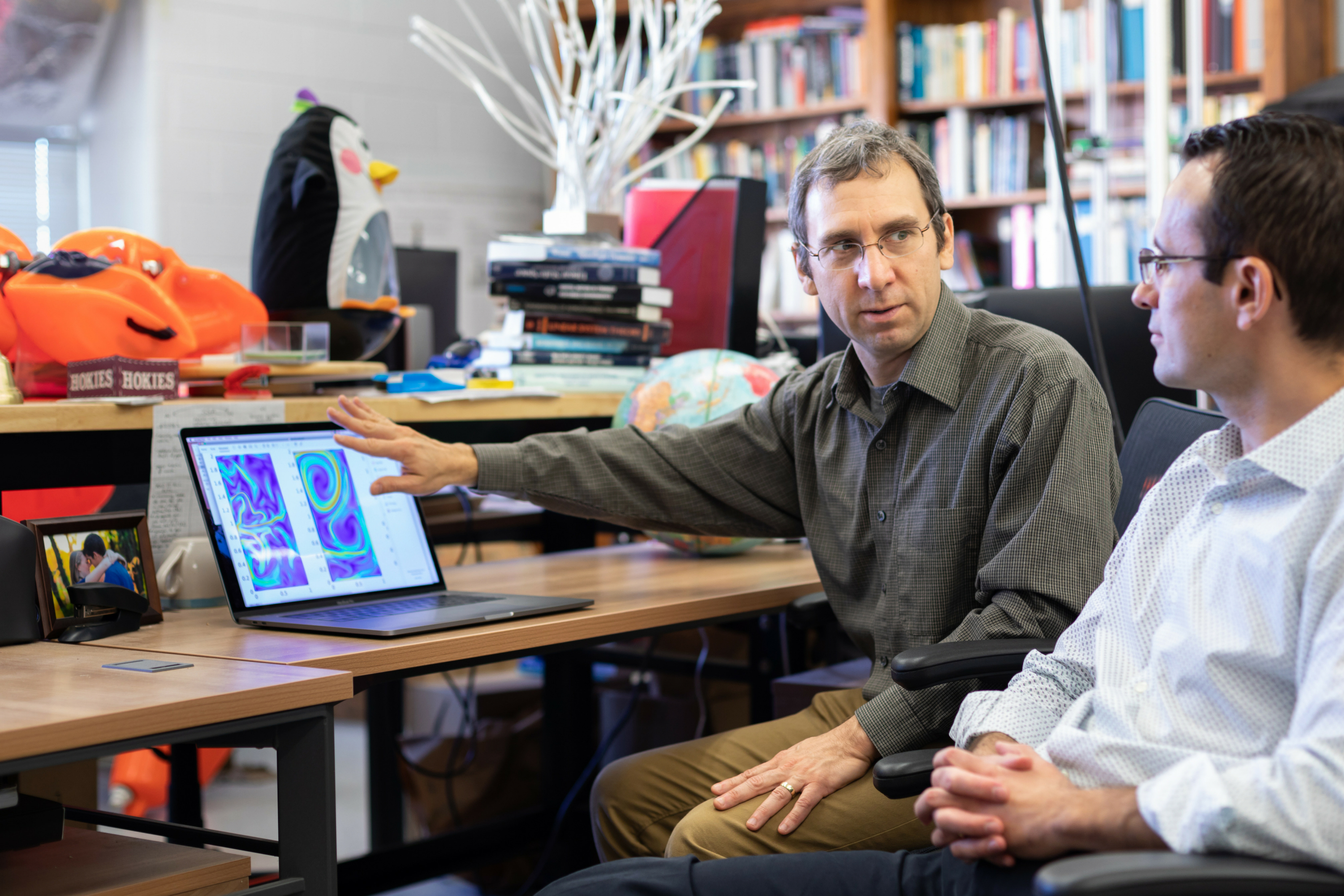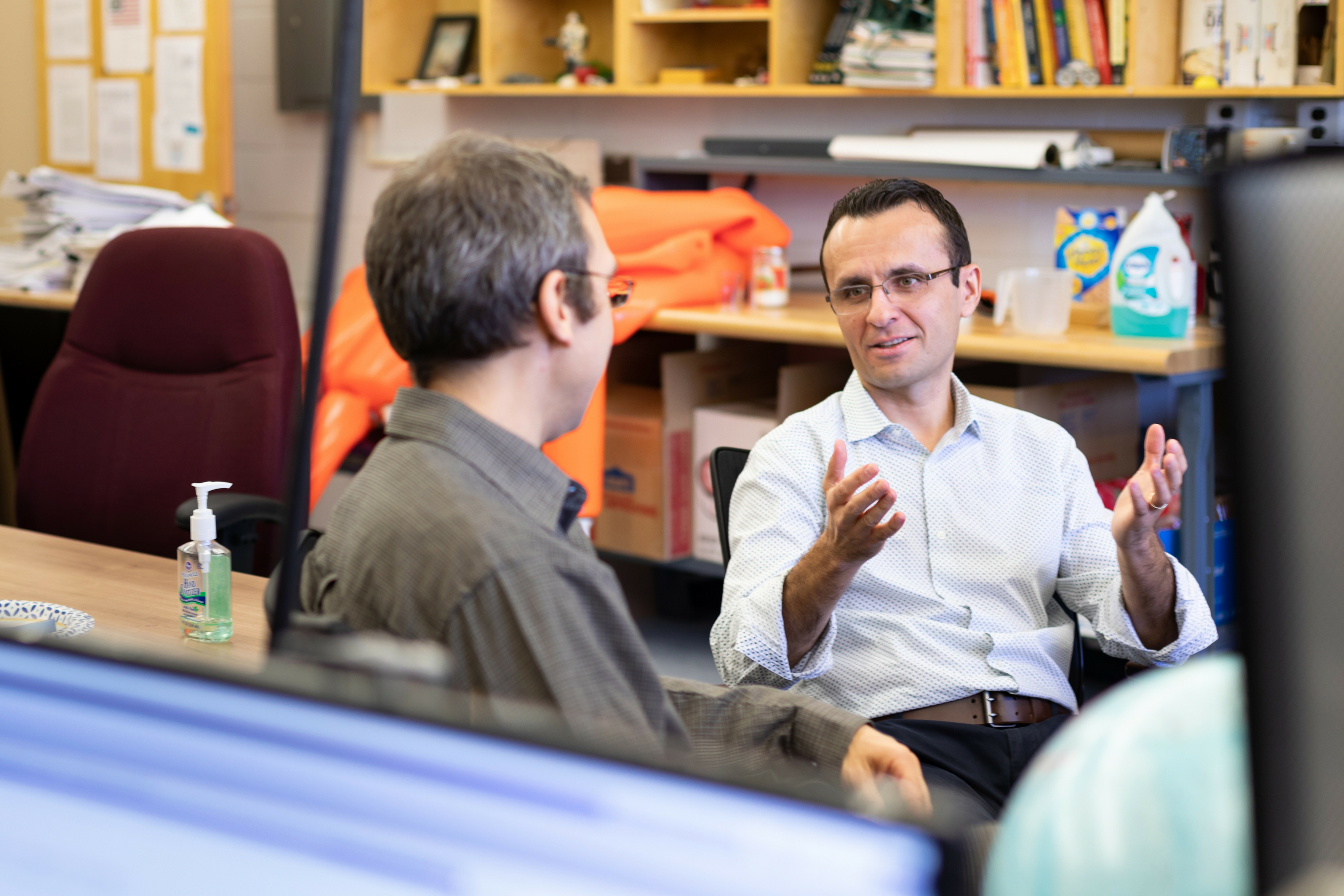Two researchers earn grant to streamline simulation of fluid contamination disasters

When oil spills in the ocean, disaster response is based on complicated simulations of the damage, which often take valuable time to render. But two Virginia Tech professors are teaming up to make this and other contamination simulations faster — potentially saving money, lives, and the environment in the process.
Shane Ross, a professor in the Department of Biomedical Engineering and Mechanics in the College of Engineering, and Traian Iliescu, professor in the Department of Mathematics in the College of Science, have been awarded a National Science Foundation grant to research how computational fluid mechanics — the use of computers to study movement of fluid — can improve forecasts of contaminant spread in the ocean, floodwaters, and atmosphere.
“When a disaster strikes, to aid decision-makers in the process of preventing or stopping the spread of contaminants, you need something that can simulate quickly,” said Ross. “These are often complicated simulations that can take days or weeks, and that’s not fast enough. We’d like to fix that. We want to be able to forecast faster, from days down to minutes.”
When a contaminant, such as an oil spill, spreads through floodwaters or oceans, it can have far-reaching detrimental impacts. Being able to predict the rate of movement of a contaminant allows for more efficient disaster response operations, which will minimize environmental damage, the costs of cleanup, and injuries on marine life.
The research also applies to people who are floating in flood or ocean waters in search and rescue scenarios. These same simulations could be used by the U.S. Coast Guard, for example, to help rescue workers find individuals who have fallen overboard in the open ocean.
The three-year, $200,000 project will focus on developing a computational model-based simulation that will quickly and accurately predict fluid transport and the rate of contaminant spread in the environment.
To do this, Ross and Iliescu will use two specific mathematical approaches: reduced order modeling, which means reducing the complexity of a mathematical equation used to solve a certain problem; and the Navier-Stokes equation, which describes the motion of fluid mechanics. When combined, these tools can streamline the computer simulation of a contaminant flow in water or air. Through reduced order modeling, the researchers will break the Navier-Stokes equation into smaller chunks so a computer can calculate fluid flow faster.
“I believe fluid turbulence is fascinating,” said Iliescu. “It is a part of everyday life, yet still a mystery. My goal is to solve this mystery, or if I can't, at least develop models that others can use in practical applications.”
By researching a wide variety of fluid applications, this model will be able to predict everything from the rate of fluid spread in the atmosphere, such as smoke from wildfires and volcanic eruptions, to chemical and biological contaminants in floodwater and oil spills in the ocean.

Additionally, this research has the potential to help farmers monitor the forecast of plant disease transport in the atmosphere, which in turn can save them huge costs on pesticide sprays.
Plant diseases, especially diseases of corn and wheat, spread through the air. For example, a wheat disease called Fusarium graminearum lands on plants and creates packets of fungal spores, otherwise known as perithecia. The spores can get caught up by wind and transported to other plants nearby or even into the next county.
"If they can get high enough, they can even cross an ocean and then land on a susceptible plant," Ross explained. "And then you have the disease spreading."
Instead of spraying everything farmers think the disease will affect, having the technology to predict how fast and where a plant disease will spread atmospherically can help them target only the plants in the disease’s path. This method will also help farmers reach their plants before the disease does, saving them time and money.
In addition to finding what Ross calls “the sweet spot between speed and accuracy,” he hopes that the research may be helpful to the general population through an app on mobile devices. Through such an app, consumers would be able to track down information about a spill or certain air pollutant.
The app would combine the mathematical formulas, knowledge of the contaminant attributes, and the user’s current environmental conditions to predict where and how fast a given contaminant is spreading. It’s a cost-effective and accessible possibility that could empower those who are making real-time decisions in the field, such as farmers or disaster response personnel, stay informed with just the touch of a button.
Iliescu believes that his collaboration with Ross is what “applied mathematics is all about.” He also appreciates the practical implications of combining math and engineering to address complex global issues.
“Mathematicians and engineers use mathematics to solve practical problems,” said Iliescu. “Along the way, they develop new ideas, methods, and tools. More importantly, they ask new, more challenging questions and train students to answer those questions.”
Written by Stephanie Kapllani







